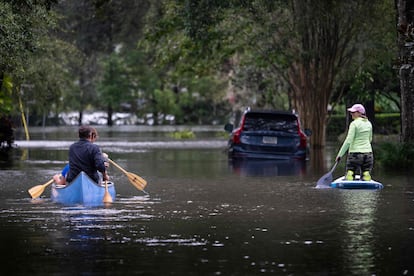Is climate change producing more powerful hurricanes?
Scientists are linking global warming to more damaging storms with heavier rainfall

The torrential rains and winds of the hurricanes that hit the Caribbean and the southeastern United States every year have long been considered part of life in these idyllic beach regions. But a recent spate of particularly powerful and destructive storms has raised questions about whether hurricanes really are more damaging than they used to be, and whether that can be attributed to climate change.
The massive destructive power of Hurricane Ian has triggered renewed interest in the effects of climate change on storm intensity. After crushing Cuba’s power grid and leaving the island nation in the dark, Ian gained strength as it crossed the Florida Straits and made landfall on Florida’s west coast with 155 mph (250 kph) winds, just under the threshold for a Category 5 hurricane (on the Saffir-Simpson scale). Five days after the hurricane ripped through the state - leaving a trail of flooding and destruction that shocked even Floridian residents who are well-acquainted with tropical storms - the death toll surpassed 100 and continues to climb.
While governments bicker over the highly politicized issue of climate change, scientists continue to publish research that demonstrates a clear connection between the increased intensity of hurricanes and humanity’s effects on the Earth’s climate. The World Meteorological Organization (WMO), a specialized United Nations agency, has acknowledged that global warming will lead to a greater frequency of Category 3-5 hurricanes, as well as higher storm-related rainfall volumes. Meanwhile, global sea level rise and coastal urban development is aggravating the impacts of flooding. “Climate science is increasingly able to show that many of the extreme weather events that we are experiencing have become more likely and more intense due to human-induced climate change,” says WMO Secretary-General Petteri Taalas.
More powerful hurricanes, more rain
Kerry Emanuel is a prominent meteorologist and climate scientist who says there is now a level of consensus among experts on how climate change affects tropical storms. “What we’ve known for quite a long time is that as you warm the climate, these storms become wetter. They produce more rain,” he says in a telephone interview. “And freshwater flooding is usually the biggest killer of all the things that happen in these storms. And also the largest source of damage.”

A study published just after Hurricane Ian hit Florida attributes at least 10% of the rainfall from the storm to climate change. “And that’s a somewhat conservative estimate of the effect of climate change,” says Michael Wehner, a climate scientist at Lawrence Berkeley National Lab and one of the authors of the study. While it hasn’t yet been peer-reviewed or published in a scientific journal, the study compared Hurricane Ian’s rainfall with about 20 computer-generated scenarios of the same hurricane hitting Florida in a world without climate change. Wehner and co-author Kevin Reed replicated a model they used for an earlier study published in Nature Communications, which concluded that rising temperatures from greenhouse gases produced rainier hurricanes during the 2020 North Atlantic hurricane season.
“In some ways, climate change supercharges the rain in the hurricanes,” Wehner adds, because of the higher humidity in the air, and all this rainfall causes greater inland and storm surge flooding in a state with accelerating sea level rise. “Most of Florida is about a foot higher. The water, the sea level is about a foot higher because of climate change. The question we don’t know so much about is: is how much larger the storm surge is because of climate change? I’m sure, is larger, but I can’t put a number on that right now.”
Rapidly intensifying storms
Wehner and Emanuel agree on two other effects of climate change on hurricanes: it makes them more powerful and intensifies them more quickly, which leaves less time for preparation and evacuation. “We’ve known for 30 years that, at least in theory, tropical cyclones can become more intense in warmer climates,” says Emanuel. “And that seems to be happening now.”

Since 2017, seven Category 4 and 5 hurricanes have made landfall on US territory, causing damage that the US National Oceanic and Atmospheric Administration (NOAA) terms as “catastrophic.” In addition, 16 of the 20 tropical cyclones during the last two North Atlantic hurricane seasons “rapidly intensified” when their wind speeds increased by at least 35 mph (56 kph) in 24 hours. This is what happened when Hurricane Fiona recently made landfall in Puerto Rico as a Category 1 hurricane, and then quickly intensified to a Category 4 as it moved out into the open ocean.
Emanuel acknowledges there is not enough consensus among scientists on how climate change affects hurricane frequency. “But because the intensity is going up, we expect the frequency of Category 4 and 5 storms to go up. Even if the frequency overall frequency of storms goes down.” This is why he believes that government authorities should be prepared to mobilize more quickly in response to weather forecasts and provide better training for those in charge of evacuations. Wehner wants mandatory compliance with evacuation orders, more frequent updating of building codes, and even advocates bans against repopulating certain vulnerable areas, although he acknowledges the political implications of such a measure. “Dangerous climate change is not our grandchildren’s and children’s problem. Our problem is here now. And the sooner we accept that fact, the sooner we can do something about it.”
Tu suscripción se está usando en otro dispositivo
¿Quieres añadir otro usuario a tu suscripción?
Si continúas leyendo en este dispositivo, no se podrá leer en el otro.
FlechaTu suscripción se está usando en otro dispositivo y solo puedes acceder a EL PAÍS desde un dispositivo a la vez.
Si quieres compartir tu cuenta, cambia tu suscripción a la modalidad Premium, así podrás añadir otro usuario. Cada uno accederá con su propia cuenta de email, lo que os permitirá personalizar vuestra experiencia en EL PAÍS.
¿Tienes una suscripción de empresa? Accede aquí para contratar más cuentas.
En el caso de no saber quién está usando tu cuenta, te recomendamos cambiar tu contraseña aquí.
Si decides continuar compartiendo tu cuenta, este mensaje se mostrará en tu dispositivo y en el de la otra persona que está usando tu cuenta de forma indefinida, afectando a tu experiencia de lectura. Puedes consultar aquí los términos y condiciones de la suscripción digital.









































